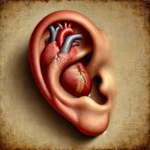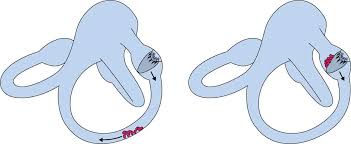
The Connection Between Cardiovascular Health and Hearing Loss:
February 24, 2025CROS and BiCROS Hearing Aids for Single-Sided Deafness (SSD)
March 18, 2025Waking up and feeling like the world is spinning can be an unsettling experience. For those with Benign Paroxysmal Positional Vertigo (BPPV), this sensation can occur with simple movements such as rolling over in bed, looking up at a shelf, or bending down to tie their shoes. BPPV is one of the most common causes of vertigo, making daily activities challenging.
What is BPPV?
BPPV is a condition that causes brief episodes of dizziness when moving the head in certain ways. It occurs when tiny calcium particles (otoconia) in the inner ear become dislodged and move into areas where they disrupt the balance system.
The inner ear can be thought of as a snow globe. Normally, everything remains still, but when shaken, the particles inside swirl around before settling again. In BPPV, these calcium crystals shift into the wrong part of the ear, creating a spinning sensation.
How the Inner Ear Controls Balance
The inner ear plays a crucial role in maintaining balance. It contains three semicircular canals filled with fluid and tiny hair-like sensors that detect movement. When the head moves, the fluid shifts, and the sensors send signals to the brain about direction and balance.
When the dislodged otoconia move into the semicircular canals, they interfere with normal fluid movement. This causes the brain to receive conflicting signals, leading to dizziness or vertigo.
Symptoms of BPPV
People with BPPV may experience:
- Sudden spinning sensations triggered by head movements.
- The feeling that the room is moving, even when still.
- Brief episodes of dizziness lasting less than a minute.
- Loss of balance when standing or walking.
- Nausea, and in some cases, vomiting.
Symptoms can appear sporadically, lasting for weeks or months before disappearing and potentially returning later.
Common Situations That Trigger BPPV
- Getting out of bed – Sitting up may cause the room to feel like it is tilting.
- Looking up – Reaching for an item on a high shelf can trigger dizziness.
- Bending over – Picking something up from the floor may cause a spinning sensation.
- Turning the head quickly – Looking over the shoulder while driving can lead to sudden vertigo.
Who is at Risk of BPPV?
While BPPV can affect anyone, it is more common in:
- People over 50, as the inner ear’s calcium crystals become more prone to dislodging with age.
- Those who have experienced head injuries from falls, car accidents, or even mild bumps.
- Individuals with inner ear infections or conditions that disrupt normal balance function.
- Those who have been bedridden for extended periods, as lack of movement can allow crystals to settle incorrectly.
Is BPPV Dangerous?
While not life-threatening, BPPV increases the risk of falls, particularly in older adults. Sudden dizziness can lead to tripping, falling down stairs, or hitting one’s head. Seeking treatment can help reduce these risks.
When to Seek Medical Help
Consult a healthcare professional if you experience:
- Frequent, unexplained dizziness.
- Spinning sensations that interfere with daily life.
- Difficulty maintaining balance.
Seek emergency care if dizziness is accompanied by:
- A severe or new headache.
- Vision problems such as double vision or loss of vision.
- Difficulty speaking, walking, or weakness in the limbs.
- Hearing loss or numbness, which may indicate a more serious condition such as a stroke.
Diagnosing BPPV
BPPV is diagnosed by specialists trained in vertigo, including audiologists, physiotherapists, ear, nose, and throat (ENT) specialists, and some general practitioners. A common diagnostic test is the Dix-Hallpike maneuver, in which the patient’s head is moved in specific ways while their eye movements are observed for nystagmus—a key indicator of BPPV.
In some cases, MRI or CT scans may be used to rule out other causes of vertigo, though they are typically unnecessary.
Treatment Options for BPPV
The good news is that BPPV is highly treatable. Most cases can be resolved with simple head movements designed to reposition the calcium crystals.

1. The Epley Maneuver
The Epley maneuver is a series of head movements a specialist performs to guide the displaced crystals back to their proper location.
- The patient’s head is carefully repositioned through a sequence of movements.
- Gravity helps shift the misplaced particles.
- Many individuals experience immediate relief after one or two treatments.
Note: Attempting these maneuvers at home without professional guidance is not advisable, as the correct approach depends on which part of the ear is affected. Incorrect movements can worsen symptoms.
2. Home Exercises
For some individuals, Brandt-Daroff exercises—specific movements designed to reduce dizziness—can be performed at home under professional guidance.
3. Medications
- Anti-nausea medications or vestibular suppressants may help alleviate symptoms temporarily.
- However, medication does not cure BPPV and should only be used in the short term.
4. Vestibular Therapy
In rare cases, if symptoms persist, vestibular rehabilitation therapy (VRT) can help the brain adapt to balance disturbances.
We are fortunate to have an excellent local physiotherapist, Kim Hawkins from Kim Hawkins Balance Therapy (www.khbalancetherapy.com.au), who specialises in treating dizziness and vertigo.
Preventing Falls When Living with BPPV
Since BPPV episodes can occur unexpectedly, it is essential to take precautions:
- Move slowly when getting out of bed or changing positions.
- Use handrails when navigating stairs.
- Sleep with your head slightly elevated to prevent crystals from shifting.
- Avoid sudden head movements, especially looking up too quickly.
Conclusion
BPPV can be disruptive, but it is a manageable condition with the right diagnosis and treatment. If you are experiencing symptoms of vertigo or dizziness, seeking help from a qualified professional can help restore balance and improve your quality of life.



